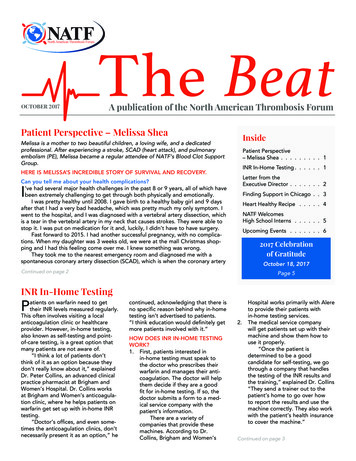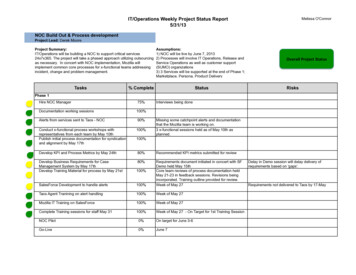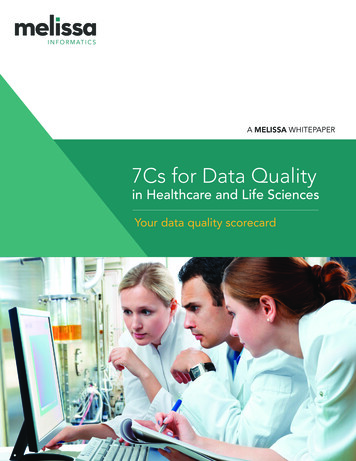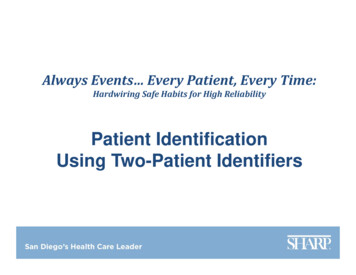
Transcription
OCTOBER 2017A publication of the North American Thrombosis ForumPatient Perspective – Melissa SheaInsideMelissa is a mother to two beautiful children, a loving wife, and a dedicatedprofessional. After experiencing a stroke, SCAD (heart attack), and pulmonaryembolism (PE), Melissa became a regular attendee of NATF’s Blood Clot SupportGroup.Patient Perspective– Melissa Shea . . . . . . . . . . 1INR In-Home Testing . . . . . . 1HERE IS MELISSA’S INCREDIBLE STORY OF SURVIVAL AND RECOVERY.Letter from theExecutive Director . . . . . . . . 2Can you tell me about your health complications?’ve had several major health challenges in the past 8 or 9 years, all of which havebeen extremely challenging to get through both physically and emotionally.I was pretty healthy until 2008. I gave birth to a healthy baby girl and 9 daysafter that I had a very bad headache, which was pretty much my only symptom. Iwent to the hospital, and I was diagnosed with a vertebral artery dissection, whichis a tear in the vertebral artery in my neck that causes strokes. They were able tostop it. I was put on medication for it and, luckily, I didn’t have to have surgery.Fast forward to 2015. I had another successful pregnancy, with no complications. When my daughter was 3 weeks old, we were at the mall Christmas shopping and I had this feeling come over me. I knew something was wrong.They took me to the nearest emergency room and diagnosed me with aspontaneous coronary artery dissection (SCAD), which is when the coronary arteryIFinding Support in Chicago . . . 3Heart Healthy Recipe . . . . . . 4NATF WelcomesHigh School Interns . . . . . . . 5Upcoming Events . . . . . . . . 62017 Celebrationof GratitudeOctober 18, 2017Continued on page 2Page 5INR In-Home TestingPatients on warfarin need to gettheir INR levels measured regularly.This often involves visiting a localanticoagulation clinic or healthcareprovider. However, in-home testing,also known as self-testing and pointof-care testing, is a great option thatmany patients are not aware of.“I think a lot of patients don’tthink of it as an option because theydon’t really know about it,” explainedDr. Peter Collins, an advanced clinicalpractice pharmacist at Brigham andWomen’s Hospital. Dr. Collins worksat Brigham and Women’s anticoagulation clinic, where he helps patients onwarfarin get set up with in-home INRtesting.“Doctor’s offices, and even sometimes the anticoagulation clinics, don’tnecessarily present it as an option,” hecontinued, acknowledging that there isno specific reason behind why in-hometesting isn’t advertised to patients.“I think education would definitely getmore patients involved with it.”HOW DOES INR IN-HOME TESTINGWORK?1. First, patients interested inin-home testing must speak tothe doctor who prescribes theirwarfarin and manages their anticoagulation. The doctor will helpthem decide if they are a goodfit for in-home testing. If so, thedoctor submits a form to a medical service company with thepatient’s information.There are a variety ofcompanies that provide thesemachines. According to Dr.Collins, Brigham and Women’s2.Hospital works primarily with Alereto provide their patients within-home testing services.The medical service companywill get patients set up with theirmachine and show them how touse it properly.“Once the patient isdetermined to be a goodcandidate for self-testing, we gothrough a company that handlesthe testing of the INR results andthe training,” explained Dr. Collins“They send a trainer out to thepatient’s home to go over howto report the results and use themachine correctly. They also workwith the patient’s health insuranceto cover the machine.”Continued on page 3
Letter from the Executive DirectorAfter months of hard work, we are delighted to officially announce the launch of the new NATF website. The web addressremains the same, www.NATFonline.org, but the experience is all new.Our goal with the new website is to provide our visitors an easier way to learn about new advances in thrombosis, provideemotional support to patients, and keep people up-to-date about NATF’s educational and outreach programs. The newwebsite is also easier to navigate and gives better access to the information you are looking for. We will be constantlyupdating our content with helpful information, articles, blogs, newsletters, announcements, and patient profiles, so be sure tocheck-in frequently.In the true spirit of NATF, we have information for both patients and healthcare providers, which we hope will help facilitatemore meaningful conversations between the two groups.Speaking of conversations, the new site also features integrated social media buttons for Facebook and Twitter to fosterimproved communication with the NATF community.We hope you find the new website fresh and modern. We worked hard to make sure the new website contains the importanthealth information you need, but we are always looking for suggestions on ways to improve.I look forward to hearing your feedback on the new website. I hope you find it useful, easy to use, and fun to engage with.As always, thank you for your support of NATF, which makes things like our new website possible.Warm regards,Kathryn MikkelsenExecutive DirectorPATIENT PERSPECTIVE – MELISSA SHEAmy medication was not correct. Obviously, something elsewas going on.So, that was definitely hard. I have two small childrenthat I need to worry about. I work. I have a family. I had a lotof questions: Should I be worried? Is this going to happento me again? What caused it?I hate to think of it as the sky is falling, but I had alreadyhad several major medical events and now this.Continued from page 1tears and slows or blocks bloodflow to the heart, causing a heartattack. After my SCAD, I didcardiac rehab and was put onseveral medications.I was emotionally affectedby the SCAD. Physically, I knewI was in good hands and I wasbeing treated by some of thebest cardiologists in the world,at some of the best hospitals inthe world. But, emotionally,I definitely had a hard time.In January of 2017, I wasMelissa and her kidsat work and noticed I was justa little bit short of breath. Nothing worth worrying about,I thought. So, I called my primary care doctor, just to ask,and she said, “You know what, with your history, you shouldprobably go to the emergency room and check it out.”So, I went to the emergency room and they did all sortsof tests, which revealed I had several unprovoked pulmonaryembolisms.How did you get connected with the NATF Blood ClotSupport Group, and how did it help?I was seeing a hematologist after my PE. As I wasleaving an appointment, I just happened to talk aboutneeding a support group. My doctor’s eyes immediatelylit up. She knew exactly what would be good for me. Sherecommended NATF’s Blood Clot Support Group.I immediately went home and signed up, and I’ve beencoming every month since. It’s helped me immensely. Idon’t want to sound corny, but it’s been a life-changingthing for me.When do you ever get doctors or nurses that areimmediately there for you? At support group, they’re hereto answer all of your question. You don’t have to wait sixmonths for an appointment. You don’t have to wait untilsomebody gets back to you by email. You have that one-onone experience in support group, and it’s been life-changingfor me.There’s only so many times that you can talk to yourfamily and your friends, but talking to people who havebeen through it is huge for me. There’s a lot less anxietyabout it.Melissa’s experience with the Blood Clot Support Groupinspired her to start her own support group for patients withSCAD.Did you have any risk factors for PE?No. I hadn’t been on a long plane ride. I hadn’t beentraveling. I didn’t sit long hours at a desk. So, there werereally no risk factors to explain why it would happen. Thatwas another emotional toll that definitely affected me.Tell me more about the emotional toll that your healthproblems caused.The biggest emotional toll that the PE diagnosis hadon me was just the unknown. I was already on a low doseaspirin. This wasn’t supposed to happen to me. Obviously,Continued on page 52
INR IN-HOME TESTING“The time in range is much better in these patients,”Dr. Collins noted. “The occurrence of adverse thromboticevents is decreased in this population.”Part of this could be related to how often these patientshave their INR levels tested. Insurance mandates that theyare tested at least twice a month. This leads them to receiving more frequent dosage adjustments to balance their INRlevels.Dr. Collins also noted that this difference in INR rangemay stem from the types of patients who seek out in-hometesting and shepherd it through the approval process. Thesepatients are often highly motivated and invested in theirhealthcare. They take their treatmentsseriously, strictly adhering to theirPT/INR Monitoringtreatment plans.Continued from page 13.Once patients are set up with their device and properlytrained in taking and reporting their INR levels, they areready to take over their own INR testing. When patientsreport their INR results, the anticoagulation clinics maketheir dosage adjustments and reports them to thepatients in the comfort of their own home.WHO IS A GOOD CANDIDATE FOR IN-HOME TESTING?INR in-home testing is a great resource that is beneficial for many patients. Dr. Collins estimates that 15 to 20percent of his patients at Brigham and Women’s Hospitalself-test.In-home testing is a great option forSystempatients who can’t make it to the lab freARE THERE ANY CHALLENGES TOquently, who travel often, or who wantIN-HOME TESTING?to be self-sufficient. It’s also good forIn-home testing is not for everypatients who have difficulty leaving theirone,and it does come with challenges.homes. Patients must be on warfarin forOnemajor issue is that the3 months before in-home testing can bein-home testing machines can be lessapproved by insurance. By doing this,accurate than testing at a clinic.patients will likely already have an estab“It’s not as accurate as venipunclished, stable warfarin dose that worksture,but we have additional tools tofor them.ensurewe’re getting the most accuWhatbenefitscomewith“Most patients think of this as arateresultand dosing it appropriateno brainer. It’s something that is morein-home testing?ly,”saidDr.Collins. “We have policiesconvenient. You don’t have to give ain place to help with that.” In-home testing is convenient.full blood sample (just a finger stick).Although self-testing machines areIt’s much less invasive,” said Dr. Collins. It allows patients to test theirapprovedby the FDA, Brigham andHowever, he noted that in-home testingINR levels without the need forWomen’sHospitaltests the accuracyis not for everyone.frequent visits to a lab.ofthemachinesthemselves.Dr. Collins“When a patient shows interest inhasfoundthatsomeofhispatient’s In-hometestingonlyrequiresain-home testing, we look at the indicamachines can be up to 20-30 percentfinger stick, instead of a fulltion for their anticoagulation. There areoff in measuring INR levels. To counbloodsample.some thrombophilias that interfere withteract this, Brigham and Women’show the machine measures the INR ratHospitalcomparestheresults of the patient’s first fewings,” he explained, citing antiphospholipid syndrome.in-hometestswithteststaken at the clinic.“For those patients we would want to avoid thePatientswhoself-testmust also understand that theypoint-of-care testing.”may have to return to the clinic for testing, if their INR levelsIN-HOME TESTING MAY LEAD TO LESS BLOOD CLOTSare found to be high.Studies show that patients who self-test have a higherAs with all forms of treatment and testing, INR in-homerate of being in the correct INR range. They spend closer totestinghas its challenges and benefits. It’s not the appropri71 percent of their time in range, compared to patients whoatetestingmethod for every patient. If you are interestedvisit anticoagulation clinics and spend 60-65 percent of theirinpursuingin-home testing, talk to your doctor to learntime in range.about what options are best for you.Finding Support in ChicagoSCELEBRATING SIX YEARS OF SUCCESSIn June, the NorthShore University HealthSystem’s ClotAware support group, hosted by Drs. Joseph Caprini andAlfonso Tafur, celebrated their six-year anniversary. NATFwas proud to attend their Thank You Meeting on June 10,2017. This exciting event was held to honor and recognizesupport group members.The NorthShore University HealthSystem’s Clot Awaresupport group serves the Chicago, IL community. Similar toNATF’s Boston-based support group, it provides a supportive environment for patients to discuss their medicalupport groups for deep vein thrombosis (DVT) andpulmonary embolism (PE) are an important part ofpost-diagnosis care for patients and their caregivers. Theygive patients an insight into how others have coped withthe disease, serve as a safe place for them to discuss theiranxieties after being diagnosed with a blood clot, and givethem access to accurate and reliable information.Here in Boston, NATF holds monthly online and in-person support group meetings, which take place at Brighamand Women’s Hospital. There are also other supportgroups across the country. One such support group is theNorthShore University HealthSystem’s Clot Aware supportgroup, located in Chicago, IL.Continued on page 43
FINDING SUPPORT IN CHICAGOBUILDING SUPPORT IN YOUR COMMUNITYWhen Dr. Caprini began his support group in Chicago,he was inspired by the work of Dr. Samuel Goldhaber, hiscolleague and the president of NATF, Ruth Morrison, RN,and Kathryn Mikkelsen, executive director of NATF. Dr.Goldhaber and Ruth started their Boston-based supportgroup over twenty-five years ago.Today, NATF is striving to provide support across theUnited States and is looking for passionate doctors andpatients to begin new support groups. Like the groups inChicago and Boston, these new support groups will help notonly provide support to patients and caregivers, but alsospread awareness in their communities.Continued from page 3treatments, share their common concerns, and learnup-to-date information about their condition.“The most helpful thing for me has been listening tothe experiences that other patients have had,” said LoisannKoestler, who has been participating in the support groupfor one year. Patients often discuss topics such as anticoagulation, compression stockings, physical challenges, or changes in lifestyle caused by their disease.“It’s been enlightening,” remarked one participant.“The group has been amazing,” said another.The Thank You Meeting featured a healthy lunch for patientsto enjoy, a poster session featuring new research, and musicperformed by several talenteddoctors. Dr. Tafur led attendees in an exciting and informative round of “Clot AwarenessBingo.”“It’s all about education andeducating the public,” said Dr.Caprini, who founded the group.He described the support groupmembers as “disciples,” who go out and spread thrombosisawareness among their friends and families. By educatinghis patients, the support group helps create a network inthe community. Participants leave the support group andwant to share what they’ve learned, so that their loved-onescan avoid PE or DVT.Are you interested instarting a blood clot supportgroup in your community?Contact Kelly Meredith atkmeredith@natfonline.orgInterested in attendingthe Chicago support groupmeetings? Reach out toNancy Lala at nlala@northshore.org. Patients, familymembers, and friends arewelcome to attend.Dr. Caprini and two supportgroup members Heart Healthy RecipeFall is in full swing. As the leaves continue to changecolor and temperatures begin to drop, warm yourselfup with a bowl of hearty chicken noodle soup.HEARTY CHICKENNOODLE SOUP3 bay leaves2 teaspoons of Italian spice blend1 teaspoon of garlic powder½ teaspoon ground black pepper1 cup of fresh dill1 (12 ounce) bag of egg noodles, cookedRecipe:1. Place your chicken breasts at the bottom ofthe crock-pot. Then, add your carrots, celery,chicken broth, water, bay leaves, Italian spiceblend, garlic powder, black pepper, and salt.2. Cover your crock-pot. Cook your soup untilthe chicken is fully cooked. This can take 8 hourson low heat or 4 hours on high heat.3. Take your bay leaves out of the soup.4. Remove the chicken from the soup and placeit into a medium bowl. While the chicken isout, stir in your dill. At this time, your crock-potshould be off, but you can leave the soupcovered to keep it warm.5. Once your chicken has cooled, cut it intobite-sized pieces. While doing this, cook youregg noodles.6. Add your chicken back into the soup.7. Place cooked egg noodles in serving bowls,and ladle soup over them.From: AmericanHeart Association’sSimple Cooking withHeart ProgramThis is a greatrecipe for peopleon the go. Justadd the ingredientstogether in a crock-pot and leave them to cook. By thetime you’re home from work, dinner is ready!This recipe is designed to be cooked in a 6-quart(or larger) crock-pot.Ingredients: 1 pound of boneless, skinless chicken breast 3 cups of peeled, sliced carrots 3 cups of chopped celery 1 can of low-sodium chicken broth 6 cups of waterHave a recipe you’d like to share? Email info@natfonline.org. We look forward to hearing from you!4
PATIENT PERSPECTIVE – MELISSA SHEANATF Welcomes High SchoolInternsContinued from page 2Melissa, can you tell us aboutthe SCAD support group youstarted?Because of the NATF BloodClot Support Group, I had theidea that if it had helped me,it would certainly help otherpeople. I reached out to mycardiologist to start anothersupport group to help survivorsof SCAD. We had our firstmeeting last week and over 50people showed up. It was hugelysuccessful. I explained to myMelissa and her familycardiologist what we do at theNATF Blood Clot Support Group, and she just kind offollowed those guidelines. It was a huge success, and I’msuper proud of that.Avanti Upad and Aryana Gavankar, high school seniorsfrom Atlanta, GA, spent part of their summer vacationinterning at the NATF office. In June, they joined us througha partnership with the Georgia Thrombosis Forum, anaffiliate organization that works with young volunteers inGeorgia to spread awareness of thrombosis. The studentsspent the month researching thrombosis awareness andhelping NATF plan for World Thrombosis Day.Here’s whatAvanti andAryana had tosay:“The pastfour weeksworking at theNATF Officehave beeninsightful,Avanti and Aryana conducting a survey atknowledgeable, Brigham and Women’s Hospitaland navigablein many ways pertaining to exploring my interests, as astudent. I learned a lot in my time at the office, specificallyin the fields of research, marketing, and publications. I didthis through several projects from creating brochures andresearching about blood clots, to running booths to spreadawareness for thrombosis.I thoroughly enjoyed researching more behind thrombosis and hearing what others have to say about it both onlineand offline. If I had another opportunity to come back, Iwould definitely take it in a heartbeat!”– AvantiAre there any last thoughts you’d like to share?I would definitely like to say thank you to Dr.Goldhaber, Ruth, and the NATF staff for putting on support groups. I know that they must hear that a lot, but it’sbeen life-changing to go from having a lot of anxiety andquestions and just having a real hard time dealing with it, tobeing able to come here, even once a month. The people ofNATF have been great. So, I can’t thank them enough for allthat they do.And I hope that, with the new support group that I’vebegun with my cardiologist, maybe someday people willthink that I’ve brought something similarly great to them.I appreciate everything that NATF does. Dr. Goldhaberhas been doing support groups for 25 years, and hopefullyhe does it for another 25 years, because I’ll be there.“The time I spent as a summer intern in NATF was both
with the patient’s health insurance to cover the machine.” Patient Perspective – Melissa Shea Melissa is a mother to two beautiful children, a loving wife, and a dedicated professional. After experiencing a stroke, SCAD (heart attack), and pulmonary embolism (PE), Melissa beca











